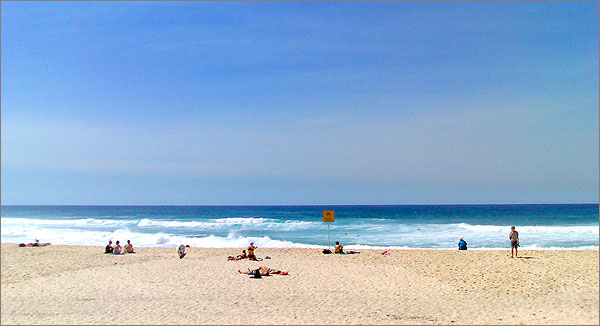
You can see why I much preferred to meet my client at Bronte Beach in Sydney’s eastern suburbs this morning, rather than an office somewhere. I’m slightly annoyed to be back at my desk now.

Word-whore. I write 'em. I talk 'em. Information, politics, media, and the cybers. I drink. I use bad words. All publication is a political act. All communication is propaganda. All art is pornography. All business is personal. All hail Eris! Vive les poissons rouges sauvages!

You can see why I much preferred to meet my client at Bronte Beach in Sydney’s eastern suburbs this morning, rather than an office somewhere. I’m slightly annoyed to be back at my desk now.
Chairman Rudd has already said he wants a bunch of good ideas to come out of the Australia 2020 Summit. In a wide-ranging interview for The Age he explained what’ll happen to those ideas.
Rudd: I think engaging the public service with something like the 2020 summit is a good thing because you have people who are mutually engaged, against not a completely free-ranging discussion, because we’ve set a policy objective for the nation which we intend to work towards. We’ve said here are the questions that we would like answers to but in terms of the menu of answers and recommendations we are completely open-minded about that. As I’ve said consistently, we’ll accept or reject what’s put forward. But the idea is to shake the tree both within government and beyond government to get people into a much more open engagement about the country’s future. I think that’s healthy.
Q: What’s the mechanism for accepting or rejecting ideas?
Rudd: We, the elected government, will do that. But what is put forward by the 2020 Summit will be their agreed recommendations, each of these ten working groups. And what we’ve indicated is by year’s end, that is within a six-month frame we will develop a formal response to what has been put forward by way of acceptance or rejection and the reasons why. I think that is a fair way to go.
In other words, the Summit is the start of a debate. After that one weekend in April it’s up to us — yeah, us Australians — to convince the government they’re worthwhile ideas (or not).
Maxine McKew and I aren’t the only ones who think Australia is ready to start a new conversation about our identity. The Australia 2020 Summit secretariat received 7251 nominations for the 1000 spots. I wish them well with the winnowing — and wish myself good luck with my own application.
The real fun now is seeing who’s actually ready for the future, and who just wants to stifle discussion.
Human rights lobbyist Howard Glenn puts it well, and shows that he’s ready:
Why am I enthusiastic about a relatively small two-day conference in April? Because it is a big gesture which says clearly that we have permission to start thinking about the future again. The flow-on effects are already starting. Schools want to have their own future summits, difficult long term issues are emerging for community debate. And that’s before it’s all really started.
It’s only two days and 1,000 people. Who gets to go is not as important as the fact that it is occurring at all, and that there’s such media attention to the attendance. Some will see it as a revival of the mythical Keating elites; the start of European-style social planning; a talk fest. I see it as the start of a restoration of confidence in Australian culture, identity and ingenuity, and a faith that we can think about future challenges, and find what we need to face them.
So what about everyone else?
Continue reading “So who’s ready for the future? Who’s not?”
Don’t newspapers fact-check any more? In the Sydney Morning Herald, Jason Koutsoukis reckons most broadband users currently receive only 256 kilobits per second. And yet, as Richard Chirgwin points out, last year’s ABS figures were that 22% of subscribers had up to 256kbps and 45% had more than 256kbps. “Since when is around 1/3 of the broadband population equal to ‘most’ users?”
A strange treat last night: I stumbled across a complete upload of the very fine 1984 docudrama Threads, which depicts the aftermath of a nuclear strike on Sheffield (and elsewhere). I’d seen it before, but it was still as powerful. Today, using The Power of Wikipedia, I discover that the scenario was based on the UK government exercise Square Leg, and that the Protect and Survive informational films it features are quite real.
Some things I found on the weekend which you might like. The UNIX-HATERS Handbook, which reminded me that for all the religious hype over Unix/Linux it really is just a kludge. (Hat-tip of the geekiest kind to Alastair Rankine.) A NY Times article How Dangerous Is the Internet for Children? Answer: not particularly. A fine Wired story about Titan Salvage, the smart, brave and somewhat scary guys who salvage ships. And Possums Pollytics’ wonderful response to an attack by The Australian‘s Dennis Shanahan.